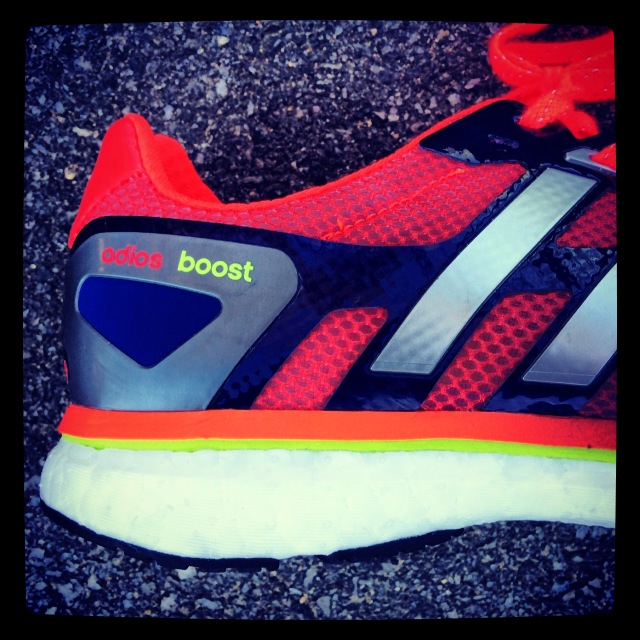 For quite a long time I’ve avoided most any shoe over 8mm drop from heel to forefoot. However, a few months ago I bought a pair of New Balance 1400v2’s after hearing positive things about them from friends (damn you John Schrup!). I never tried the 1400v1 because the drop was above my preferred range (I’m a bit of a dropist), but I wound up loving the v2. I’d go so far as to say that it’s one of my favorite shoes of the year. I still have issues with other high drop shoes, and have come to realize that I can tolerate a higher drop if a shoe is not overly stiff and the heel has some give.
For quite a long time I’ve avoided most any shoe over 8mm drop from heel to forefoot. However, a few months ago I bought a pair of New Balance 1400v2’s after hearing positive things about them from friends (damn you John Schrup!). I never tried the 1400v1 because the drop was above my preferred range (I’m a bit of a dropist), but I wound up loving the v2. I’d go so far as to say that it’s one of my favorite shoes of the year. I still have issues with other high drop shoes, and have come to realize that I can tolerate a higher drop if a shoe is not overly stiff and the heel has some give.
What I love about the 1400v2 is that it has a soft heel and a firm forefoot, it’s lightweight, and the fit is just right for a performance shoe. The 9mm drop didn’t bother me much at all. Given this experience, I was intrigued by the adidas Adios Boost, which has a 10mm drop and looked similar in its construction (the fact that it was the shoe on Geoffrey Mutai’s feet when he won the NYC Marathon didn’t hurt…). I reviewed the adidas Adios 2 last year and was surprised by how much I liked it, though the fit was tight up front and the heel was a bit firm. I contacted adidas to see if I could get ahold of a review sample of the Adios Boost, and they agreed to send a pair out (Disclosure: these were media samples provided free of charge by adidas. Read more about my approach to writing honest reviews here.).
I was pretty hard on adidas when they first started marketing their Boost midsole material, and I still stand by what I wrote. Boost is different than typical EVA midsole foam in that it is composed of thermoplastic beads that are fused together. adidas claimed that the Boost midsoles would last longer, would not be as temperature sensitive, and would provide greater energy return than EVA. I didn’t have a problem with these claims as they can be validated by mechanical testing data. My issue was the implication that improved energy return from Boost would increase running economy and thus performance (they did not have data to link the mechanical testing data to actual physiological performance). There is still no published data that I am aware of supporting the ability of Boost to improve performance, though an abstract with scant details from a scientific meeting suggested a 1% improvement in economy in Boost shoes.
Anyway, I’m still a sucker for new shoe technology, and I was first sent a pair of the Energy Boost shoes by adidas. They didn’t work out for me at all. The midfoot was very tight, and there was way too much sole flare around the heel. The shoe got in the way of my stride big-time, and I only took them on a few runs. That being said, the Boost material did indeed feel different, particularly if I forced a pronounced heel strike. Very bouncy.
As a racing shoe, the adios Boost seemed like a better match for me, and it turns out that I was correct. I’d rank the adios Boost right up with the NB 1400v2, Newton Energy, and Saucony Virrata as one of my top shoes of 2013 (still deciding on #5!).
To be honest, the adios Boost is really quite similar to the New Balance 1400v2. They feel very similar on the run, drop is almost identical, and fit is similar as well. The big differences are that the adios Boost is about 1.5 ounces heavier (7.8 oz in men’s size 9 for the Adios vs. 6.4 oz for the 1400v2), maybe a bit stiffer/more responsive, and $60 more expensive (that to me may be the deciding factor here…).
So what do I like about the adios Boost? Mainly that it runs really smooth and disappears on my feet. The heel is very soft, and the forefoot is firm, and this is a combo that I like in a lot of shoes (already mentioned the 1400, but also the Newton Energy). I tend to land on the midfoot or very lightly on my heel and a soft heel makes for a very smooth transition for my stride (whereas a firm, inflexible heel like in the Mizuno Sayonara just doesn’t work with my stride). The firm forefoot feels great when picking up the pace. I much prefer the Adios Boost sole as compared to the overall firmer sole of the Adios 2.
Upper
I’d describe the fit of the Adios Boost as just right. The forefoot width is not too tight, not too wide (if you have wide feet they probably will not work for you), and I didn’t have any issues with toe squeezing.
I was a bit concerned when I first put these shoes on that the midfoot would be too tight. adidas shoes sometimes cause me trouble when the adidas stripes are sewn onto the upper, and I felt a bit of digging in the arch at first (this made the adidas Gazelle 2 a no-go for running for me). After wearing them around a bit the upper broke in/stretched and the sensation went away. I’ve had no blistering or abrasion in them on runs, so all seems to be ok. However, like the NB 1400v2 the interior of the upper is a bit scratchy and I wouldn’t advise running sockless in them.
One more thing about the upper – the adios Boost does have a hard heel counter, whereas the 1400v2 does not, so that’s something to consider if deciding between the two and you have a preference one way or the other. (I might add that the upper looks awesome, my wife even gave it a thumbs up which is rare among shoes I run in).
Sole
The sole of the adios Boost is really the selling point for this shoe, so I’ll address a few things about the Boost midsole.
I’ve already mentioned the bouncy feel in Boost shoes, but it’s worth pointing out that the bouncy sensation really only applies to the heel in the Boost shoes that I’ve tried. I think that once the sole thickness drops below a certain height the bouncy sensation disappears and the sole takes on a firmer feel (less room for sole deformation).
I haven’t put enough miles on these to address durability claims, but I can speak to the temperature effect. I live in New Hampshire, and this time of year it’s pretty darned cold. Below freezing most days, and the low is projected to be right around O degrees Fahrenheit tomorrow night. Cold. A lot of shoes with EVA soles start feeling like bricks when you run in cold weather like this. They lose their cush. I can attest that the Boost remains bouncy when running in cold temps, but again you’ll only really notice it in the heel. To me, this might be the most revolutionary attribute of the Boost compound.
The outsole of the adios Boost has plenty of rubber, so I suspect durability of the sole to be very good overall. As mentioned, the sole has good stiffness and is responsive – I could see using it for races from the 5k to the marathon with no problem. There is a “torsion system” which consists of a plastic web under the midfoot with three prongs extending forward under the forefoot – these are likely responsible for the longitudinal stiffness you feel in this shoe.
Conclusion
I really, really like this shoe. A lot. My biggest concern is the price – at $140 MSRP are they worth spending $60 more than a pair of New Balance 1400v2 or maybe Saucony Grid Type A5’s? Not sure I’d go so far as to say that. They will garner some sales due to the heavy marketing of the Boost midsole, but prices are going to need to come down for me to recommend these highly over competitors. That being said, the adios Boost would definitely be a contender for me as a marathon shoe – it’s among the best I’ve run in this year.
Where To Buy (affiliates)
The adios Boost is available for purchase at Adidas.com. Outside of the US, the adios Boost is also available at Wiggle.

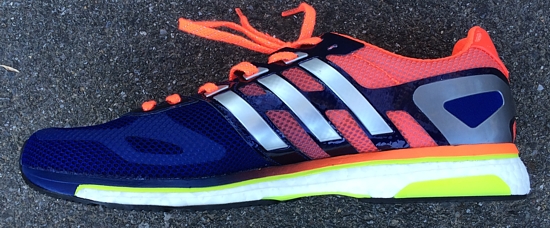
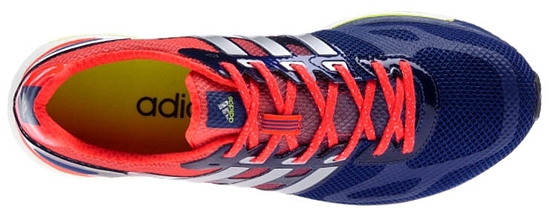
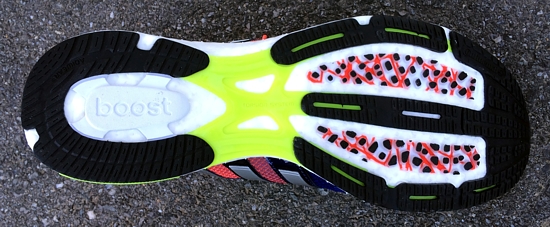

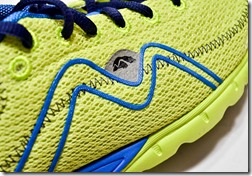
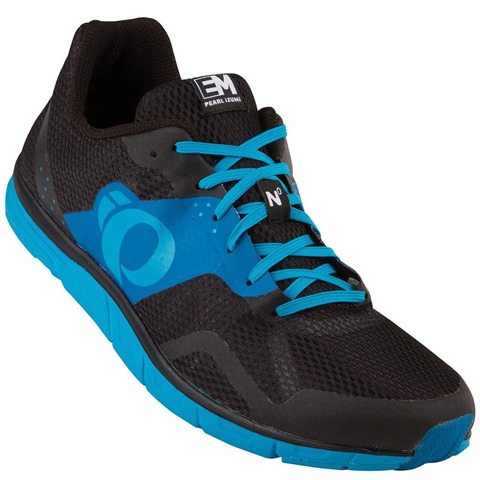















Nice review.
I find the forefoot in the AdiZero Boost to be more cushioned than the NB 1400v2, but then again I am larger than you.
Here’s a thought experiment — if you are running with a midfoot (or, even better, forefoot) strike, and provided that the drop is not so large as to make you land heel-first, does the drop in a running shoe really make any difference? To put more nuance on it, assume that the runner is not overstriding.
I suspect this is why you are happy with the NB 1400v2 and the Adidas AdiZero Boost — no real impact on your stride.
What do you think, Mr. Larson?
It’s a great question, and I’m not sure of the answer. I do tend to land slightly back toward the heel most of the time. There are definitely some higher drop shoes that don’t work well for me, the Sayonara being a good example, and I have a hard time in more traditional shoes. I have the new Saucony Guide and I’d include that there. So, there’s definitely more to it than just drop, and using drop alone to pick shoes is not always a great idea I don’t think.
Before this goes much further, I think it’s important to note that this is a review for the Adios Boost, not the Adistar Boost, which is a much different shoe. That being said, I think that stride cadence leading to short striding leads to efficient foot strike. There are some shoes that can work well, regardless of drop, but some shoes with short drops where I’ll notice wear further back. Find a shoe that will disappear on your body and you will run well.
Like in the NB 1400v2 there’s way too much heel, not enough ground feel and not enough flexibility for my taste – or in other words it ain’t a minimalist shoe.
Seems like you are moving a bit away from the minimalist shoes Peter?
Depends on how you define minimalist. I’ve never been a pure minimalist runner if you define it as zero drop, minimal cushion. The shoe I’ve put the most miles on in the past 5 years would be the Saucony Kinvara, which probably has more cushion than either the adios Boost or NB 1400. I like shoes that are lightweight and simple in costruction, I don’t mind cushion (actually prefer a bit) and use a range of drops.
Pete, interesting and important that it is not just absolute “drop” heel to toe that makes a shoe feel good. I agree this is one fine shoe to go fast in. The upper is a bit hard to dial in but once dialed in it is just fine. I wonder given your midfoot tending stride if it is not just the firm forefoot and a touch of soft heel when you need it that makes these feel good for you. There is enough Boost in the mid foot to both cushion and propel. I find the adios not much fun at slower speeds kind of harsh but really fantastic at speed, Might this be that when you launch off the combination of thin forefoot with boost and stiff torsion strips there is a spring effect. My late September review of the adios boost here link to samwinebaum.blogspot.com
Could be Sam. I tend to like any shoe with a softish heel and a respsonive ride. But, they feel great at easy pace for me as well and it may be that since I don’t have a pronounced heel strike I don’t compress the smaller amount of Boost in this shoe compared to the Energy Boost.
I keep trying to tell myself that I don’t like this shoe because it’s not a racing flat, too heavy, too big a drop, too much cushion, yada, yada…but the fact is I do like this shoe. I might end up using it for marathons starting in the spring. I think the high price is offset by the fact that these things will last forever with the boost material and the Continental rubber.
If they do last longer than say the NB 1400 that may justify the cost. My guess is the upper goes before the sole.
Maybe I haven’t been running long enough, but I’ve never had a problem with the upper blowing out on my shoes. As a matter of fact, I think I could run in all of my shoes, even the original Pure Connects from Dick’s Sporting Goods I got almost two years ago that started me down the minimalist path. Even the Piranha SP 3s that I’ve run tons of races in still have some life left in them.
This is where blogs like yours could really fill a deficiency of magazine reviews: How long do the damn shoes last?
I love the NB 1400s, v. 1 a little more than v. 2. But their durability is lacking (outsole wear and midsole compression). So in a year’s time, would buying one pair of Adios Boost work out to being better financially than two pairs of the 1400?
It’s a great question Scott and I agree. The problem is that addressing long term durability is really tough if you do a lot of reviews, and doing fewer reviews with more miles on each shoe leaves a lot of bases uncovered. I’m usually pretty open about the fact that I can’t comment on durability, it’s a tradeoff to being able to comment on a lot of shoes. But, I often ask for comments from those who have put more miles on a shoe. On the plus side, if I have a shoe that starts to fall apart before I review it, it’s definitely one to avoid! (e.g., NB 730v2)
The 1400’s are a good shoe but they have Eva and I find that after about 20 miles the foam gives out a little. But with the boost I felt the same response for the whole 26 miles so for a marathon race shoe I would go with the adios.
Speaking of my experience with the Energy Boost, I’ve got over 800 miles on concrete and they’re not done yet. The Boost midsoles and the outsoles, both of which seem to be comparable to the Adios boost, have held up great.
Thanks for this, it is the review of the year for me!
Let me just start by saying that on your recommendation I tracked down a pair of (expensive, in Canada, at 140$) NB1400V2s, and I quite like them, though not as much as my origional Adios2s. They are quite a bit more flexible in the forefoot, and so require your foot to do a lot more of work than the adios2s — I would run up to 9 miles in the 1400V2s on a soft surface, but would prefer the adios2s for anything longer or on pavement, as you feel less beat up afterward. But both give you a feeling as you run of being totally at one with the road or trail, something the Kinvara3s (also recently bought on closeout due to your recommendation) do not give –though they do give much more cushioning than either, which is very important to me now that the temperatures are at -10C for a high here in Ontario. At those temps, the NB is a very, very hard shoe indeed, but the Adios2 isn’t so bad, and I look forward to the Adios boost in that regard.
But to comment on one aspect that purist minimalists won’t like: certainly the drop of the shoe is obviously only one factor in the overall design package that makes a shoe great or not. Both the Adios and 1400 series are worn by the most elite of the elite for a reason — they are designed to help you run fast, which is more of a consideration than whether or not they meet some purity mm-drop standard. FWIW, I own and run in FiveFingers, NB Minimus and Nike Free 3.0s, and all of those make your foot work far more than an elite marathoner or 10k athlete would want on race day. There’s a certain forefoot “structure” to the Adios2s for a reason: to transfer the work of moving forward from the foot to the leg muscles.
I run in my more minimal shoes to vary the stresses and to build up foot strength etc. But for races I would wear spikes on the track and the 1400V2 or Adios2 for longer distance road races. I’m still looking for the perfect 5k road shoe!
Thanks for the comment! Sounds like we share a similar philosophy on shoe usage :)
Almost all elite-runners are sponsored by Nike or Adidas who kind of dictates which shoes they run in.
Meb runs a pretty decent marathon in the GoRuns which in my eyes are a minimal shoe with a low drop, high flexibility and a good ground feel. He’s probably one of the few elite runners who got a saying about what kind of shoe he want’s to run in.
I’m far from an elite runner myself but have set new PR’s after starting running in minimal shoes and got a marathon time around 3 hours so I don’t think they are bad competition shoes.
@Pete: I think you once wrote that a minimal shoe is defined by being flexible, low drop and light weight (or else I read it another place :P). Well that’s also how I personally define a minimal shoe and the Adios Boost or NB 1400 V2 doesn’t live up to any of those criterias in my eyes.
The Kinvara is kind of a cross between a traditional trainer and minimal shoe in my eyes.
Meb runs marathons in the GoRun Speed, not the GoRun. He helped design it from the ground up and it’s a stiff distance racing shoe just like the adios Boost and NB1400. Longitudinal stiffness is a characteristic you’ll find in almost any racing shoe. Elites may be sponsored by Nike and Adidas, but they could choose any shoe made by these companies. The elite Kenyans aren’t racing in the Adidas Gazelle, they almost all use the Adios.
Pete, what is the reason/potential biomechanical advantage of longitudinal stiffness in race shoes. If there is an advantage can anyone’s race pace take advantage of it or is fast paces that get most pop out of the stiffness.
I think the idea is that you may get a bit of spring-back at toe off after bending a stiff sole during stance.
Hello Peter,
I must say I love your reviews, I often wonder if we were born with the same feet…I am currently using Saucony Kinvara 3’s for my longer runs, and my wife just bought me a pair of Grid a5′ s which as you recommended I uped a half size from 10 kinvara to 10.5 grid a5. I’m gonna use the a5’s for anything 5k to 10 mile races and speed,track work. I was just wondering if there is a shoe you might use for recovery days other than a Kinvara as I have recently been getting some it band issues after about 6-7 miles into a run along with a bit of heel/ achillies soreness. I tried Saucony ride 6 but they drive my achillies nuts and seem to high even at 8mm drop. I seem to gravitate toward Saucony as the Kinvaras have served me well, but am open to suggestion on other brands maybe…I land mid foot with slight heel from time to time as we’ll?
Thanks Larry! You could try the Saucony Mirage, which is also 4mm drop and a bit more traditional in its construction, or maybe one of the Brooks Pure shoes (Flow, Cadence). I’d also put a plug in for the Skechers GoRun as a recovery shoe, nice soft ride and super comfortable.
So, the midsole might make the runner 1% more oxygen efficient (what oxygen efficiency gains translate into in terms of speed is another question which I’ve never found a good answer to) than when running in the 1400, but the extra 3 oz (1.5/shoe) will make them 1% less efficient…so it equillibrates, with the chief difference being the runner is $60 poorer with the Adios?
Yeah, that’s the problem with the energy return claims about Boost, all depends on what you compare it to. Might be better than another identical shoe of same weight with and EVA sole, but not necessarily better than a lighter shoe with similar specs with an EVA sole. The question here would be durability – will the Boost shoe justify the $60 premium by lasting longer. Unfortunately as someone who reviews a lot of shoes I usually don’t get enough miles on each to answer that one.
I love these shoes. I was using the lunaracers for a race shoe which are about 3 ounces lighter than the adios but when I started using the adios boost my times were significantly faster. I started running a year ago and ran my first marathon in the adios boost and ran a 3:06 bq. These shoes held up great the whole race. I know why the elites use these and not merrels. They are a well thought out piece of performance equipmentt. They will defiantly be my race shoe from now on.
I’ve been running in the Lunaracer as well and much prefer the Adios Boost. I find the Lunaracer a bit too mushy and the fit is a bit tight up front.
I am a size 11.5 in the kinvara 3 with plenty of room in the front. What size would you recommend for these?
Tough call. I wear a 10 in Kinvara 3, 10.5 in Kinvara 4, 10.5 in Adios Boost. If you have plenty of room in the front of the K3, 11.5 might work out.
Pete, do you realize with power comes responsibility? Do you realize what impact you have? Now I want these shoes as well. I already wanted another pair next to my Kinvara3s for the long runs, so don’t feel bad about it.
Have a good 2014!
Sorry :)
Don’t be Pete. I bought them fourth week of January and I love them. Did almost 100 km (60 miles) already in them – including a 30 km (14 miles) run. Great shoes. I already feel like these will replace my Virratas as the shoe for my official races. A great shoe next to my minimal shoes.
This afternoon these shoes helped me run a personal best on the half marathon City Pier City The Haguu. Almost a minute below my previous Virrata record. Great shoes. Thanks a lot for bringing them to my attention Pete.
The Hague that is!
Congrats!
Interesting review, thanks. Didn’t you have an article last year saying that neutral running shoes caused you to overpronate? The Adios Boost don’t do that? I could use that as even the Tempo+orthotics are causing me problems in my left foot/ankle now.
Don’t think I wrote that, maybe something along the lines of a shoe can be the cause of overpronation. The only shoe that I’m pretty sure caused an injury due to causing overpronation is the NB MT110 which ha a slanted sole from lateral to medial.
Sorry, it took me a while but I found the article I was thinking of link to runblogger.com
I started running 4 months ago and quickly found I had an overpronation problem in my left leg so I got stability shoes…and developed ITBand problems…so I got orthotics but they didn’t really seem to help…so I switched to a forefoot strike with the Skechers GRR1 and the knee problems didn’t come back but now after 6 weeks my left ankle is getting painful :-( What a saga, eh ! Not sure what to do now…
Do you prefer this or the Hagio? Comparison?
Hagio is firmer and stiffer, would probably choose it for speed/5k. Adios boost for 1/2 marathon to full.
Hello pete..simple question about sizing..i wear size 42 for adios2..and it fits great..and I’m about to order the adios boost, but can’t test them..should i order the same size (42)? Thanks before
I think so. I had a 10 US for the Adios 2 and it was small on me, went up to 10.5 in the Boost and was good. So probably should have worn 10.5 in both – similar sizing.
I see..thanks a lot pete
Now I need a new pai of running shoes
The Adios Boost is a big improvement on the Energy Boost, with more room in the upper and a much better “road feel”. The Energy Boost was too cushioned, unstable and not enough tactile feedback to promote good form.
If Adidas would shave a couple additional millimeters of thickness from the heel height and do something to soften up the shoelace eyelets so they didn’t dig in to the top of my foot as much, this could be The Perfect Shoe.
Just a little background before I get started – I’m 43 years old, 6’2″ and 205lbs and I’m not built for running at all – add in a knee surgery 6 years ago and it really isn’t for me.
That being said – over the past 8 years I’ve done two full Ironman races and countless half ironmans and Olympics. Needless to say I have to run – a lot.
I’ve tried several shoes, and the Adidas Boost is the first shoe that allows me to run in every day. Before the Adidas Boost shoe came out I could run about 3 days a week before the dull pain in my knee would start keeping me up at night.
I also play basketball – one time a week with significant pain the next morning in my knee.
I started wearing my Adidas Boost shoes for hoops as well. My knee still feels hurts the next day but not nearly as bad.
My point in all this – if you are a heavier, not built for running kind of guy with some old sports related injuries that nag you but don’t keep you from getting out there and competing – Try the Adidas Boost – the cushion is fantastic – noticeable the second you walk in the shoe and the next day your body will thank you. In fact, it might even let you do it all over again. I’m a big fan because its changed how many days I can work out in a row now.
Hope this helps some of you out there….
Thanks for adding in your experience Tom!
I have wide feet, and still found these to be wide enough. Not as roomy as my Pegasus 4E, but OK.
The outsole on the heel isn’t a durable as I’d like. But other than that, I am quite pleased.
Anyone know where/when these are coming back to the USA? I’m a size 10.5, and I cannot find a single store online anywyere, that has these in stock.
There’s apparently been limited supply, Running Warehouse mentioned it somewhere, can’t recall where. I think I hear more coming in Spring/Summer timeframe.
Footlocker has them in stock online all sizes. Chatted with an adidas.com online rep tonight and sure enough, all sizes two colors (orange and blue).
Thanks for the info, they seem to have been in limited supply until recently.
What did you mean by, “The shoe got in the way of my stride big-time?”
Meaning it was not a good match for my running form. Felt kind of like I was fighting the shoe while I was running in them, not comfortable for me.
I have an interesting thought on what Adidas could do differently in order to establish a thorough cushioned feel in all of their Boost midsole shoes all the way from the heel-forefoot. Note: I’m pointing this out because, as you said, the Boost midsole shoes have too much of a dramatic heel-toe offset so that you only get that great cushioned feel if you’re a heel striker.
I would find it that it’d be much more productive for Adidas to make a shoe that utilizes the Boost midsole but has a lower heel-toe drop (0-4mm offset for example) so that the Boost midsole cushion could be felt not only in the heel but in the midfoot & forefoot as well. This well suit not only heel strikers but will 1. propose better foot strike while utilizing a great cushioning system, and 2. will open up the door to a wider range of runners.
Hello sir. I still hope that you will read this comment. I just have one simple question. It could be answered by a YES or NO. I’m a runner who has a “normal” foot form and uses Nike Lunar Forever 2 as my running pair. I’m a stability runner. Will the adidas adios boost work out for me during a half marathon run? Thank you so much sir!
Pretty impossible to tell, I’m of the opinion that you need to try a shoe in training before using it in a race. That’s the only real safe way to go about it.
Interesting review, thanks. Was wondering if you’d had a chance to try the Adios Boost v2 and been able to compare them. I’ve been running with the Glide Boost and tried the Adios Boost v1 to have a “faster” shoe but I’m not impressed with the “stiff/plasticky” upper, similar to the GoMeb Speed 2.
I’m a forefoot/midfoot striker and do prefer the ground feel of the Adios Boost v1 compared to the harder GoMeb, a lot “softer”, yet still responsive.
Yes, my adios Boost 2 is coming next week (Monday I think). The upper is completely changed, a bit softer and more traditional. I would recommend going a half size up in the Adios Boost 2 from what you have tried in v1. Fit has changed a bit, feels a bit pointier up front.
Hi Peter,
I’m really tempted to try this shoe for a marathon next spring. I’ve been running in inov-8 233 and 155 over the summer and, while they’ve been great for the 10K’s I’ve been racing, I don’t think they are enough shoe for me for the full marathon distance.
I’ve been a big fan of the Kinvara in the past, but I now think they’re too cushy for me, now that I’ve adapted to the firmer ride of the Inov-8s. Looking at your review for the adidas, it seems like it could potentially be the perfect marathon shoe for me: firm in the forefoot, with some cush in the heel for those later miles.
What’s your view on how the fit compares to the Kinvara? I’ve been in UK10.5 for these shoes (and I’ve downsized to 10 for the Inov8s).
Thanks,
Pete
hi pete–it looks like you left the lacing the way it arrived, with the laces entering the holes from above rather than from below as they usually do. did you find this works better for this shoe?
thanks.
Personally never noticed any issues with this. My feet are pretty high volume so they fill a shoe well and typically I don’t have lacing issues.